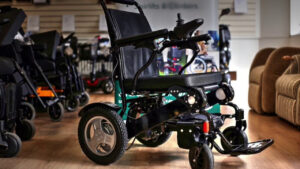
The global electric wheelchair market is estimated to be valued at US$ 8.71 Bn in 2024 and is expected to exhibit a CAGR of 11.% over the forecast period 2024 to 2031.
Electric wheelchairs are specifically designed wheelchairs that are powered by batteries or other propulsion systems. They provide mobility assistance to the disabled or elderly population suffering from various physical disabilities which impair their mobility. Battery-powered electric wheelchairs are durable, rechargeable, and provide maximum independence. They allow users to navigate indoor and outdoor spaces with control, speed, and accessibility that cannot be matched by a manual wheelchair. The global electric wheelchair market is driven by the rapid pace of technological advancements leading to the development of smart, lightweight, and foldable electric wheelchairs with long battery lives.
Key Takeaways
Key players operating in the electric wheelchair market are Invacare Corporation, Sunrise Medical (US) LLC, Permobil Inc., Pride Mobility Products Corporation, Drive Devilbiss Healthcare, Hoveround Corporation, Ottobock Healthcare, 21st Century Scientific, Inc., Meyra GmbH, LEVO AG, Merits Co. Ltd., Segway Inc., Scewo, GF Health Products Inc., Karman Healthcare, Inc., KYMCO Healthcare, SOWECARE B.V, and Nanjing Jin Bai He Medical Apparatus Co., Ltd.
The growing prevalence of physical disabilities worldwide due to various medical conditions and the rising geriatric population are major demand drivers in the global electric wheelchair market. According to WHO, over 1 billion people live with some form of disability globally. As per United Nations, the number of people aged 60 years and older is expected to double by 2050.
Key manufacturers are expanding their presence in developing regions through collaborations and partnerships. For instance, Invacare Corporation has distributor agreements across Asia Pacific and Latin America to address the growing needs in emerging healthcare markets. Several players are developing affordable and customizable electric wheelchairs specifically designed for low-income users in developing countries.
Market Key Trends
Technological advancements are a key trend shaping the electric wheelchair market. Manufacturers are developing smart electric wheelchairs integrated with IoT, sensors, and mobility assistance solutions. For example, 21st Century Scientific has launched Kinesia, an AI-powered electric wheelchair that uses sensors and computer vision to navigate obstacles autonomously. Some manufacturers are designing modular electric wheelchairs that can be customized as per the changing needs of the user over time. Lightweight lithium-ion batteries with longer lives are enabling advanced features such as app-based control and remote assistance. The demand for technologically advanced, multifunctional electric wheelchairs is expected to surge in the coming years with growing healthcare requirements of the aging global population.
Porter’s Analysis
Threat of new entrants: The threat of new entrants is moderate due to high initial investment required for production of electric wheelchairs and established brand recognition of existing key players in the market. However, entry barriers are lower due to growth opportunities presented by aging population globally.
Bargaining power of buyers: The bargaining power of buyers is high due to availability of substitutes and undifferentiated products offered by various manufacturers. Buyers can easily switch to alternatives based on price and additional features.
Bargaining power of suppliers: The bargaining power of suppliers is moderate as raw material inputs are common. However, suppliers still hold bargaining power due to dependencies of manufacturers on consistent supply of quality components.
Threat of new substitutes: The threat of new substitutes is moderate as mobility scooters and manual wheelchairs provide alternative options to consumers.
Competitive rivalry: Competitive rivalry is high owing to presence of numerous global and regional players competing on the basis of product pricing, innovation, quality and additional value-added services.
Geographical Regions
The electric wheelchair market in North America is currently the largest in terms of value, accounting for over 30% of the global market share in 2024, driven by factors such as high per capita healthcare spending in the US and Canada.
The Asia Pacific region is anticipated to emerge as the fastest growing market for electric wheelchairs during the forecast period from 2024 to 2031, expanding at a CAGR of over 13%. This high growth can be attributed to increasing healthcare access and expenditure, growing senior citizen population as well as infrastructure investments across densely populated countries like China and India.
*Note:
1. Source: Coherent Market Insights, Public sources, Desk research
2. We have leveraged AI tools to mine information and compile it



